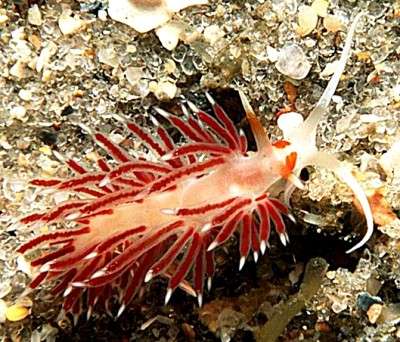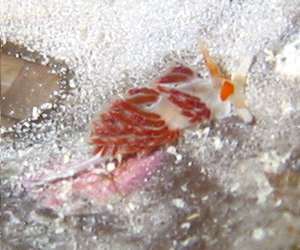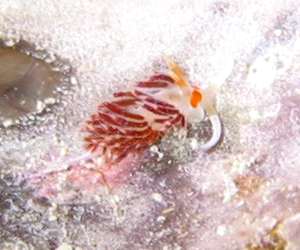
Learchis evelinae
Edmunds & Just, 1983
Order: NUDIBRANCHIA
Suborder: AEOLIDINA
Family: Glaucidae
DISTRIBUTION
Caribbean
PHOTO
West Palm Beach, Florida, USA, in 12 feet, approx 20mm long, February 19, 2000. PHOTO: Anne DuPont.
Body translucent clear with some white speckling. Upper three quarters of oral tentacles are opaque white. The smooth tapering rhinophores are multicoloured with a basal translucent clear band, then an orange mid region, then an opaque white upper third. Edmunds & Just describe an orange line on each side of the head from the base of the oral tentacle to the base of the rhinophores. In the photographed specimen here the orange line is replaced by an orange patch. There are scattered white marks on the dorsum and a median white line on the posterior part of the foot. No information on the colour of the cerata was given by Edmunds & Just. The animals they described were from Barbados and ranged from 3-9mm long.
Reference:
• Edmunds, M. & Just, H. (1983) Eolid nudibranchiate Mollusca from Barbados. Journal of Molluscan Studies, 49(3): 185-203.
Rudman, W.B., 2000 (February 25) Learchis evelinae Edmunds & Just, 1983 . [In] Sea Slug Forum. Australian Museum, Sydney. Available from http://www.seaslugforum.net/find/learevel
Related messages
Learchis evelinae from Florida
January 26, 2005
From: Phillip Gillette


Hi, i can't figure out exactly what this nudibranch is, and thought maybe you could help. This photo was taken off of Virginia Key, Biscayne Bay, Fl. It was at night, in 20 ft of water. This particular photo was taken on 4-2-04, but i have seen them on numerous other occassions. Sorry the picture isnt great, all of the ones I have seen have been under 1cm, and are hard to get good photographs of. I thought that it could be Learchis evelinae, but it does not have the white tips on the cerata. Thanks so much for your time.
Locality: Virginia Key, Biscayne Bay, Florida, USA Atlantic
Depth: 20 ft. Length: 5-10 mm. 2 April 2004
Channel, on sponges. Photographer: Phillip Gillette
Thanks again!
Phillip Gillette
pgillette1@hotmail.com
Gillette, P., 2005 (Jan 26) Learchis evelinae from Florida. [Message in] Sea Slug Forum. Australian Museum, Sydney. Available from http://www.seaslugforum.net/find/12931Dear Phillip,
I am pretty sure this is what is being called Learchis evelinae. You'll see from the earlier discussion that we are still learning about the colour variation in this species and its relationship to Learchis poica. At this stage it seems the bright reddish patches on its 'cheeks' are a good indicator.
Best wishes,
Bill Rudman
Learchis evelinae from Florida
September 23, 2002
From: Bill Rudman
While checking up on Anne's message about her mystery aeolid from Florida I discovered that I had forgotten to change the identity of an earlier aeolid from Learchis poica to Learchis evelinae Edmunds & Just, 1983. I see I had been waiting for further discussion - which never occurred.
As Sandra Millen's message discusses, distinguishing features of L. poica are the weakly perfoliate rhinophores. Has anyone some photos of Learchis poica I could add to the Forum?
Best wishes,
Bill Rudman
Learchis poica or Learchis evelinae?
February 26, 2000
From: Sandra Millen
Hi Bill & Anne,
I think the mystery aeolid is Learchis evelinae Edmunds & Just, 1983 because they mention orange cheek lines, orange at the base of the rhinophores and smooth rhinophores. I have examined a similar specimen and the extra bursa they use to distinguish it from L. poica is not very distinct (just a swelling) so they may turn out to be the same species. Keep an eye out for one with annulate rhinophores. Good photo.
Sandra
Department of Zoology,
University of British Columbia,
Vancouver, B.C., Canada, V6T 1Z4
millen@zoology.ubc.ca
Millen, S., 2000 (Feb 26) Learchis poica or Learchis evelinae?. [Message in] Sea Slug Forum. Australian Museum, Sydney. Available from http://www.seaslugforum.net/find/1976Thanks Sandra,
The plot thickens! I think I'll leave it as L. poica at present in case the discussion continues. I don't want to have to change filenames etc more than once.
Best wishes,
Bill Rudman.
Learchis poica? from Florida
February 25, 2000
From: Anne DuPont

Dear Bill,
I took this photo Saturday night, February 19, 2000, West Palm Beach, Florida in 12 feet of water. The little critter was about 3/4
inch to 1 inch long and was crawling along on the sand, in an area covered with hydroids.
Is it Learchis poica?
Thank you again for your time.
Cordially,
Anne DuPont
adupont@gate.net
DuPont, A., 2000 (Feb 25) Learchis poica? from Florida. [Message in] Sea Slug Forum. Australian Museum, Sydney. Available from http://www.seaslugforum.net/find/1962Dear Anne,
Learchis poica Marcus & Marcus, 1960 was first described from preserved animals, which is always a bit of a problem for later identification. The first description of live animals by Marcus mentioned cerata covered in white blotches and a white ring in the cnidosac region. The rhinophores also have irregular rings. But no mention of the red patches on the side of the head.
Malcolm Edmunds (1964) described animals from Jamaica with red 'cheek patches' like your photo. No description mentions the orange band on the rhinophores, that your photo shows.
So basically I think its this species but I will wait for confirmation from a local expert.
Best wishes,
Bill Rudman.
